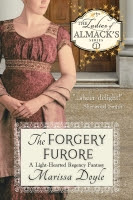Here’s another post in our
ongoing series on Regency fabrics.
As I have in previous posts, I’ll be examining actual fabric samples glued into several earlier editions of Ackermann’s Repository, samples supplied by the manufacturers and published by Ackermann in order to boost the British cloth-making industry at a time when exporting British goods to Europe was almost impossible because of the Napoleonic war. I'll give you a close-up scan of each sample, the published description if available, and my own observations of the color, weight, condition, and similarity to present-day materials, to give you as close a picture as possible of what these fabrics are like.
As I have in previous posts, I’ll be examining actual fabric samples glued into several earlier editions of Ackermann’s Repository, samples supplied by the manufacturers and published by Ackermann in order to boost the British cloth-making industry at a time when exporting British goods to Europe was almost impossible because of the Napoleonic war. I'll give you a close-up scan of each sample, the published description if available, and my own observations of the color, weight, condition, and similarity to present-day materials, to give you as close a picture as possible of what these fabrics are like.
Today’s four samples are from
the September 1812 issue of Ackermann’s Repository.
The overall condition of my copy is very good; the page itself is free of foxing and barely, if at all, toned; the sample in white has suffered some
foxing, but that's probably unavoidable.
Here we go!
No. 1. A celestial blue imperial striped sarsnet, adapted for pelisses, spencers, evening robes, and mantles. Silk fringe of the same colour, matted crape, Spanish binding, and thread lace, or net, are the only appropriate trimmings for articles of this delicate and pliant material. It is sold by Messrs. George and Bradley, mercers, No. 19, Holywell-street, Strand.
My comments: Alas, it’s no longer possible to see just how celestial the blue was in this sarsnet was: only a hint of color can be seen now. The fabric itself, though, is lovely stuff: it possesses a delightfully silky hand and a shimmer that would indeed make for a beautiful “evening robe.”
No 2. A sea-weed ground printed
cambric, so evidently calculated for the humble order of morning and domestic
wear, that no further remark is necessary, than to recommend robes of this
article to be made high in the neck, with long sleeves, and frills or collars
of lace or needle-work. We are furnished with this print from the house of
Harris and Co. No.1, Picket-st. Temple Bar.
My comments: A nice, sturdy cambric fabric, evenly woven. The background seaweed print is finely printed in a tannish orange; the larger brown pattern has either run, or wasn’t as well printed in the first place, having left brown streaks on the background.
No. 3. A beautiful fancy silver paper for ladies’ work-tables, boxes,
card-racks, &c. When made up, it exhibits the appearance of the red
sea-weed, strained on a white satin or silver ground. Work-tables, with ebony
and gold frames and feet, or japanned to that effect, are a most unique,
elegant, and useful article for the boudoir. For card or work-boxes the narrow
embossed gold or silver border is a appropriate finish at the edges. This
simple and tasteful article is from Ackermann’s, 101, Strand.
My comments: Okay, forget what I said about the samples being in
good condition. While it’s just possible to see the seaweed pattern and a hint
of red on this sturdy but not too thick paper, the silvery background has long
since oxidized away, alas—it must have been pretty. I have to wonder, by the by, why there's a paper sample amongst the fabrics; did a fabric merchant forget to send along his samples?
No. 4. A striped Scotch jaconot muslin, designed for the morning dress
and children’s ware. Lace, or borders of double or plaited muslin, are the only
becoming and consistent trimmings for robes of this article. It is sold by
Charles Cooper and Co. No. 47, Fleet-street.
My comments: Very finely woven and, as a result, very sheer...but also very pretty and delicate. Charming as a child’s smock, or in a morning dress over a lining or slip.
What do you think of this
month’s fabrics?










1 comment:
The samples would be lovely if only the natural dyes were colorfast! Thanks as always for your insightful comments.
Post a Comment